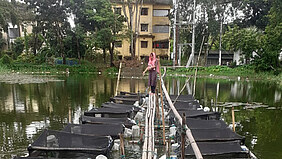Several biological benefits are associated with protein hydrolysates and they have been used in finfish larval and juvenile diets for several decades now, mainly due to their high palatability and digestibility.
Symrise Aqua Feed has been producing functional protein hydrolysates for more than 20 years and recently it has promoted the long-term use of a new generation of liquid hydrolysates formulated as palatability enhancers (PE, Extrapal range; Seguin et al., 2020 & 2021; Soller et al., 2019) in carnivorous fish species dietary formulations. In terms of dietary compositions, these species require palatable raw materials, such as fishmeal. As they are very sensitive to stressful events, which often result in reduced feeding, both farmers and feed manufacturers readily accept the benefits of using PE.
In contrast, freshwater omnivorous fish species are not perceived to require palatants per se and are considered as less demanding. In these species, feed acceptance becomes an issue during very specific periods, such as wintering. Challenges quoted by freshwater fish farmers are mostly related to feed costs and disease outbreaks.
Symrise Aqua Feed has developed a cost-effective solution to meet these needs by designing ActiTuna Oil which is formulated with the right balance of tuna oil and protein hydrolysate, to make top coating application easier for feed manufacturers as a one step process. The product is designed to increase feed palatability and digestibility for omnivorous fish aiming at the reduction of cost of feeds in farming.
To evaluate the performance of ActiTuna Oil in omnivorous fish species, two feeding trials were carried out with the tilapia (Oreochromis sp) and pabda or butter catfish (Ompok bimaculatus). These two fish species are commonly farmed in Bangladesh. The study took place at Sylhet Agricultural University, Bangladesh.

